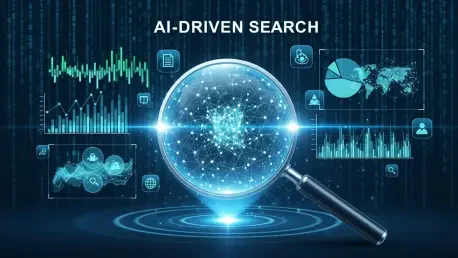Setting the Stage: The AI-Driven Search Revolution
In the current digital landscape of 2025, search engine optimization (SEO) faces a transformative challenge as artificial intelligence (AI) reshapes how users access information, with only about 36% of searches resulting in clicks to non-Google properties due to the prevalence of AI Overviews providing instant answers directly on the search results page. This zero-click search phenomenon signals a critical turning point for marketers who once relied heavily on organic traffic to drive engagement.
The purpose of this market analysis is to dissect the evolving SEO ecosystem, focusing on the integration of AI, the growing emphasis on user intent, and the enduring relevance of trust-building frameworks like Google’s E-E-A-T (Experience, Expertise, Authoritativeness, and Trustworthiness). By examining current trends and projecting future dynamics, this exploration aims to equip digital marketers, business owners, and content creators with actionable insights to navigate a highly competitive environment.
Understanding these shifts is not just a strategic advantage but a necessity. As search engines prioritize efficiency and personalization, businesses must adapt to maintain visibility and relevance. This analysis delves into the key forces driving change, offering a comprehensive look at how the market is responding and what lies ahead in this AI-dominated era.
Deep Dive into Market Trends: AI, User Intent, and Trust as Core Drivers
AI Overviews Reshaping Traffic Patterns
One of the most significant trends dominating the SEO market in 2025 is the widespread adoption of AI Overviews in search engine results. These summaries, which aggregate content from multiple sources to provide quick answers, have drastically reduced traditional click-through rates. Marketers now face the challenge of capturing attention in a landscape where users often find what they need without visiting external sites, pushing the need for content optimized for featured snippets and AI-generated responses.
To counter this, businesses are leveraging AI tools to streamline content creation, using them for ideation and drafting while maintaining human oversight to ensure depth and originality. The risk of over-reliance on automated outputs looms large, as search engines continue to prioritize high-quality, authentic material. However, the opportunity to appear in AI summaries offers a new visibility channel for those who structure content effectively, focusing on concise, authoritative answers to specific queries.
This trend also highlights a broader market shift toward efficiency in information delivery. As AI continues to refine search dynamics over the next few years, from 2025 to 2027, projections suggest an even greater reliance on zero-click results. Companies that adapt by balancing technological innovation with unique value propositions stand to gain a competitive edge in this evolving space.
User Intent at the Forefront of Optimization Strategies
Beyond the impact of AI summaries, the market is witnessing a pronounced pivot toward user-centric optimization. Search engines are increasingly sophisticated in deciphering user intent—understanding not just the keywords typed but the underlying purpose of each query. This has elevated the importance of crafting content that aligns with specific user needs, whether informational, transactional, or navigational.
Technical SEO remains a critical component, with metrics like Core Web Vitals playing a pivotal role in rankings. These measurements, focusing on loading speed, interactivity, and visual stability, are especially vital for mobile users who dominate global internet traffic. Businesses that fail to prioritize seamless experiences risk losing ground, as mobile-first indexing is now a non-negotiable standard in the industry.
Additionally, community engagement and social proof are emerging as key differentiators. Earning backlinks from reputable sources and optimizing for contextual relevance through entity-based strategies are gaining traction over traditional keyword stuffing. This holistic approach presents an opportunity to build deeper connections with audiences, though it demands a careful balance of technical precision and meaningful content to avoid pitfalls like neglecting foundational SEO elements.
Trust and Ethical AI Use as Market Differentiators
Another defining factor in the current SEO market is the heightened focus on trust, encapsulated by Google’s expanded E-E-A-T framework. With AI tools becoming ubiquitous, demonstrating expertise and infusing personal experiences into content are essential for establishing credibility. Case studies, firsthand insights, and transparent authorship help brands stand out amidst a flood of generic, automated outputs.
Ethical AI usage is also shaping market perceptions. Industry consensus emphasizes using AI for analysis and ideation rather than over-optimizing content, which can trigger algorithmic penalties. This cautious approach is particularly relevant as consumer trust in digital content wanes, with users growing skeptical of material lacking authenticity or depth.
Regional variations further complicate the landscape, as local SEO gains prominence in fragmented markets. Personalized strategies tailored to specific geographies, coupled with integration across digital channels like social media, are proving effective in boosting visibility. The market rewards brands that prioritize transparency and quality, reinforcing the idea that trust is not just a ranking factor but a long-term investment in audience loyalty.
Emerging Patterns and Future Projections
Looking at the trajectory of SEO beyond the current year, several emerging patterns indicate further disruption and opportunity. The rapid integration of machine learning tools into marketing workflows suggests a deepening reliance on AI for tasks like competitor analysis and content planning. Social platforms, such as TikTok, are also carving out a role as alternative search engines, particularly among younger demographics, necessitating optimization for hashtags and voice-driven queries.
Technological advancements aside, potential regulatory changes around data privacy and AI ethics could redefine market norms, especially in regions with strict compliance requirements. Economic pressures may drive smaller businesses toward cost-effective AI solutions over traditional agency services, reshaping budget allocations. Projections for the coming years, from 2025 to 2028, point to increased cross-functional collaboration, with SEO merging more seamlessly with content marketing, paid advertising, and social media strategies.
Speculatively, the market could see search engines evolve to prioritize immersive formats, such as augmented reality results, blending digital and physical interactions. This would further challenge marketers to innovate in how they present information. Staying ahead will require agility, a commitment to monitoring behavioral shifts, and an openness to experimenting with new formats and platforms as they gain traction.
Reflecting on the SEO Market: Strategic Pathways Forward
Looking back on this analysis, the SEO market in 2025 reveals a complex interplay of AI-driven innovation, user intent, and trust as foundational elements. The dominance of AI Overviews reshaped traffic patterns, while the emphasis on user-centric design and technical excellence underscored the need for adaptability. Trust, bolstered by ethical practices and frameworks like E-E-A-T, emerged as a critical differentiator in a crowded digital space.
The implications of these findings point to a market that rewards strategic foresight. Businesses that integrate AI responsibly while prioritizing authentic storytelling gain ground, even amidst challenges like zero-click searches. Emerging trends, from social search platforms to potential regulatory shifts, hint at a landscape that will continue to evolve rapidly in the years that follow.
Moving forward, the focus shifts to actionable next steps. Marketers are encouraged to audit websites for technical performance, particularly on mobile, and to diversify strategies across local SEO and social channels. Investing in community-building efforts and monitoring algorithm updates become essential for sustained visibility. Ultimately, the path to success lies in blending technological efficiencies with a relentless focus on user needs, ensuring that brands not only adapt to change but shape it through innovation and purpose.









